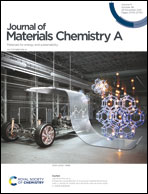Conditions for efficient charge generation preceded by energy transfer process in non-fullerene organic solar cells†
Abstract
The minimum driving force strategy is applied to promote the exciton dissociation in organic solar cells (OSCs) without significant loss of open-circuit voltage. However, this strategy tends to promote Förster resonance energy transfer (FRET) from the donor to the acceptor (D–A), a consequence generally ignored until recently. In spite of the advances reported on this topic, the correlation between charge-transfer (CT) state binding energy and driving force remains unclear, especially in the presence of D–A FRET. To address this question, we employ a kinetic approach to model the charge separation in ten different D/A blends using non-fullerene acceptors. The model considers the influence of FRET on photoluminescence (PL) quenching efficiency. It successfully predicts the measured PL quenching efficiency for D or A photoexcitation in those blends, including the ones for which the D–A FRET process is relevant. Furthermore, the application of the model allows to quantifying the fractions of quenching loss associated with charge transfer and energy transfer. Fundamental relationships that controls the exciton dissociation was derived evidencing the key roles played by the Marcus inverted regime, exciton lifetime and mainly by the correlation between the driving force and binding energy of CT state. Based on those findings, we propose some strategies to maximize the quenching efficiency and minimize energy loss of OSCs in the presence of D–A FRET.



 Please wait while we load your content...
Please wait while we load your content...